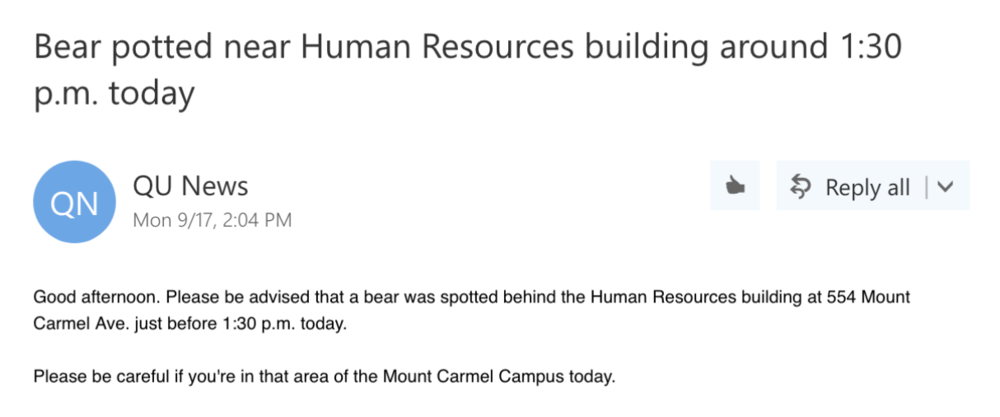By Cullen Ronan, with reporting by Paige Meyer and Mackenzie Campbell
Quinnipiac University notified teachers and students of a bear sighting behind the human resources building around noon on Friday, Oct. 5.
This marks the second bear sighting at Quinnipiac in just the past month and the third this year. The last spotting occurred on Sept. 17 in the same location on Mount Carmel Ave.

Before that, a black bear was seen this past May, as witnesses say it was near the Harwood Gate located on the university’s main campus.
Edmund Remillard, a human resources employee, witnessed the animal intruder in September.
“I was greeting a colleague at the HR House. Upon his arrival he pointed to the bear, which was walking on the grass along the back parking lot,” he said. “The bear walked by, stepped over the field stone wall and proceeded up Sleeping Giant.”
Despite seeing what he believed to be a “250 to 300 pound” bear in the wild, Remillard says he wasn’t phased, choosing to admire the the animal.
“It was beautiful and did not seem to notice or have any interest in us,” he said.
These frequent bear sightings haven’t only been isolated to just Quinnipiac University, however, as according to the Department of Energy and Environmental Protection, Connecticut has tallied 7,799 reports of black bear activity across the state within just the last year.
Hamden currently has 85 reported black bear sightings since September of 2017, and the Hamden Police Department took to its Facebook page advising residents of increased local bear activity.
According to the Connecticut Department of Energy and Environmental Protection, black bear sightings are becoming increasingly common in Connecticut as the population continues to grow and expand.
Wildlife Biologist Paul Rego wasn’t shocked upon hearing about the two bear sightings at Quinnipiac, also noting the yearly rise in population.
“I was unsurprised because we have a growing bear population that is expanding its range and it wouldn’t be surprising to have a bear in the area. The Connecticut bear population is increasing from 10-15 percent each year.”

Despite Remillard’s relatively tame interaction, Rego advises that residents take some precautions around their home in order to protect themselves and their pets.
“Residents should take time and prepare in order to reduce the chance of bears coming near their homes and around residential areas. My advice would be to move human waste sources such as garbage cans, trash bags and bird feeders from your front and back yards.”
The Connecticut Department of Energy and Environmental Protection has also issued a list of black bear do’s and don’ts in order help educate residents on black bear safety, as well as a black bear sighting report form in order to further keep track of bear activity.
This story was updated on Oct. 5, 2018